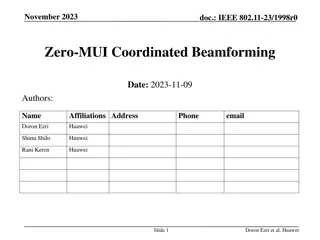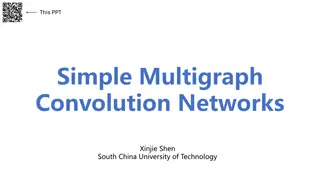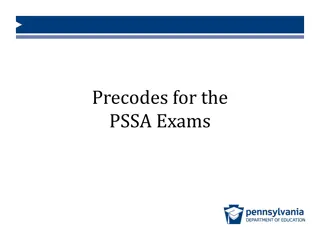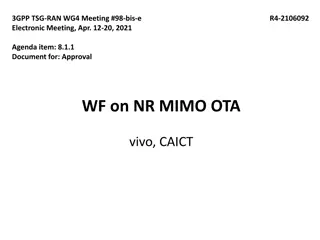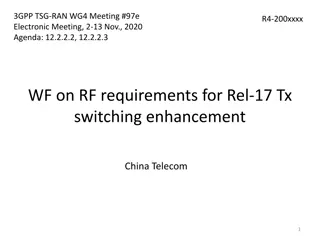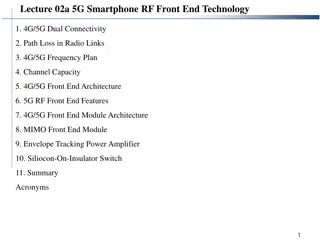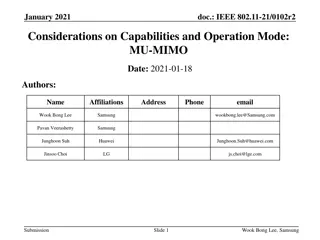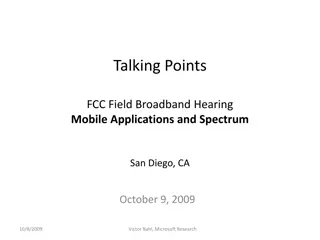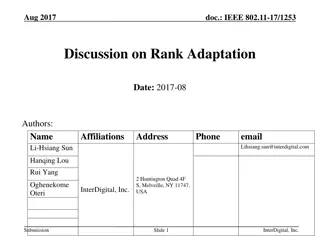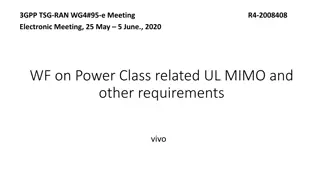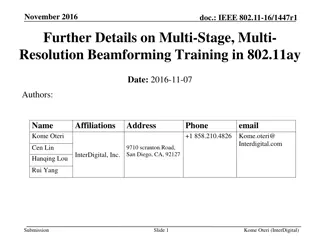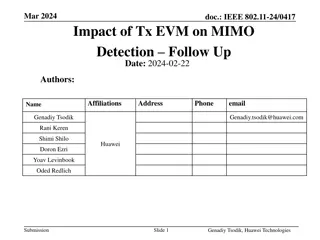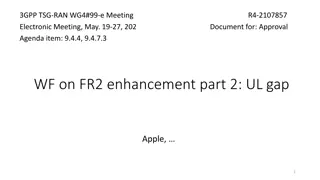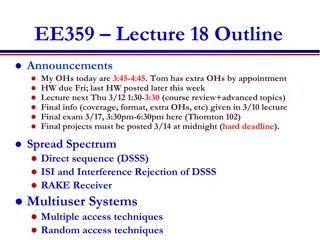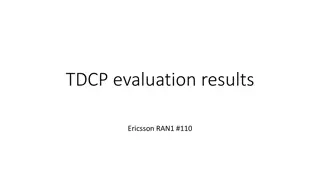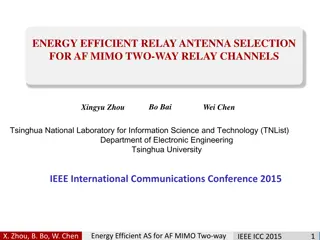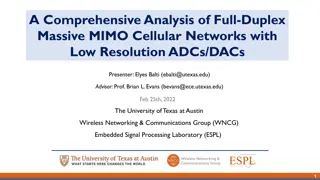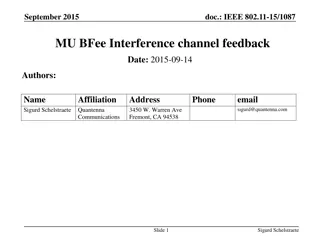Enhancing DL MU-MIMO with Improved Precoding Techniques
In this document, Dzevdan Kapetanovic from Ericsson discusses the limitations of standard DL MU-MIMO precoding for BPSK and proposes enhanced precoding and decoding methods for better performance. By applying these strategies to complex-valued alphabets, significant improvements are observed based on simulation results. The use of Zero Forcing (ZF) and Regularized Inverse (RI) techniques in DL MU-MIMO scenarios is explored, highlighting the importance of optimal precoding strategies for maximizing system efficiency.
Download Presentation

Please find below an Image/Link to download the presentation.
The content on the website is provided AS IS for your information and personal use only. It may not be sold, licensed, or shared on other websites without obtaining consent from the author.If you encounter any issues during the download, it is possible that the publisher has removed the file from their server.
You are allowed to download the files provided on this website for personal or commercial use, subject to the condition that they are used lawfully. All files are the property of their respective owners.
The content on the website is provided AS IS for your information and personal use only. It may not be sold, licensed, or shared on other websites without obtaining consent from the author.
E N D
Presentation Transcript
May 2016 Some Notes on Interference Alignment for Downlink Multi-User MIMO Date: 2016-05-15 Authors: doc.: IEEE 802.11-16/665r0 Name Dzevdan Kapetanovic Affiliations Address Ericsson Phone +46- 107146951 email dzevdan.kapetanovic@eri csson.com Mobilv gen 1 22 362 Lund Sweden Submission Slide 1 Dzevdan Kapetanovic, Ericsson
May 2016 doc.: IEEE 802.11-16/665r0 Abstract We show that standard DL MU-MIMO precoding for BPSK is severely suboptimal We propose an improved way of precoding and decoding BPSK symbols Similar ideas are applied to complex-valued alphabets Simulation results show the improvements Submission Slide 2 Dzevdan Kapetanovic, Ericsson
May 2016 doc.: IEEE 802.11-16/665r0 Introduction DL MU-MIMO introduced in IEEE 802.11ac Up to 8 Tx antennas at AP Linear precoding in DL improves performance Zero Forcing (ZF) and Regularized Inverse (RI) popular choices Straightforward with full spatial multiplexing and complex-valued alphabets If one of these conditions do not hold, is it still trivial? Submission Slide 3 Dzevdan Kapetanovic, Ericsson
May 2016 doc.: IEEE 802.11-16/665r0 Example AP with 4 Tx antennas 4 STAs with one antenna each Channel ? = [?1 AP transmits one BPSK symbol to each STA ? = ??? + ? Precoder ?, vector of BPSK streams ? = ?1?2?3?4 Standard ZF: ? = ?+ (pseudo-inverse) [1] ? = ? + ? Each STA receives BPSK without interference ?; ?2 ?; ?3 ?; ?4 ?] ? Submission Slide 4 Dzevdan Kapetanovic, Ericsson
May 2016 doc.: IEEE 802.11-16/665r0 Example (cont.) Standard ZF results in beams that are orthogonal to both I and Q parts of undesired users Since the constellation is one dimensional, orthogonality towards the other dimension not necessary [2] Beams that are orthogonal to only one dimension have one extra degree of freedom / STA placed on the other dimension interference from others Let AP choose signaling dimension for each STA (in such a way so that the resulting linear precoder has minimal power). Submission Slide 5 Dzevdan Kapetanovic, Ericsson
May 2016 doc.: IEEE 802.11-16/665r0 Example (cont.) AP constructs a ZF precoder that only nulls out one dimension / STA Also works for RI precoder Submission Slide 6 Dzevdan Kapetanovic, Ericsson
May 2016 doc.: IEEE 802.11-16/665r0 Implementation A possible implementation of the proposed method The AP collects all received channels (or some factorization of them) and extends them to the real-valued domain It chooses I or Q as the channel to a STA in such a way that the resulting ZF or RI has minimal energy The STA processes the signal in the I-Q (real-valued) domain; standard MU-MIMO IC receiver [1] no longer optimal! Submission Slide 7 Dzevdan Kapetanovic, Ericsson
May 2016 doc.: IEEE 802.11-16/665r0 Complex-valued alphabets Example considered BPSK (in general, one-dimensional constellation) How about complex-valued (QPSK, 16-QAM, )? The single antenna now receives two independent dimensions no possibility to choose anymore Submission Slide 8 Dzevdan Kapetanovic, Ericsson
May 2016 doc.: IEEE 802.11-16/665r0 Complex-valued alphabets (general) Already well-known that, in case of fewer streams than Rx antennas at each STA, AP can place interference on the other (complex) subspaces Possibility to choose gives gain Strongest eigenmodes not always optimal! How about having additional choice of placing it on I or Q parts in the different subspaces? Simulations show that there is no gain compared to the complex-valued representation Submission Slide 9 Dzevdan Kapetanovic, Ericsson
May 2016 doc.: IEEE 802.11-16/665r0 Summary In case of BPSK, AP has freedom to place interference on I or Q part more degrees of freedom STA must process in the I-Q domain IC receiver suboptimal Standard MU-MIMO Large gains compared to standard ZF For complex-valued alphabets, no need to place interference on I or Q separately However, choosing subspaces gives gain! Submission Slide 10 Dzevdan Kapetanovic, Ericsson
May 2016 doc.: IEEE 802.11-16/665r0 Straw poll Do you support that 802.11ax implements a selection mechanism in conjunction with improved receiver capabilities for BPSK? Yes No Abstain Do you support that 802.11ax implements a selection mechanism for reduced rank transmission with complex- valued symbols? Yes No Abstain Submission Slide 11 Dzevdan Kapetanovic, Ericsson
May 2016 doc.: IEEE 802.11-16/665r0 References [1] Robert Stacey and Eldad Perahia, Next Generation Wireless LANs , 2nd edition [2] Rodrigo de Miguel, Ralf R. M ller, Real vs. Complex BPSK Precoding for MIMO Broadcast Channels Submission Slide 12 Dzevdan Kapetanovic, Ericsson


